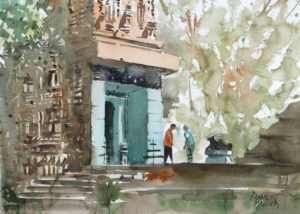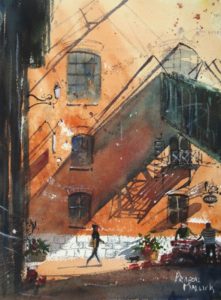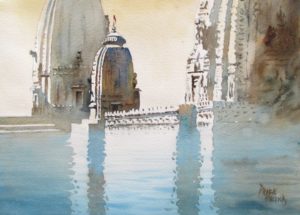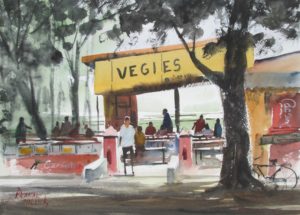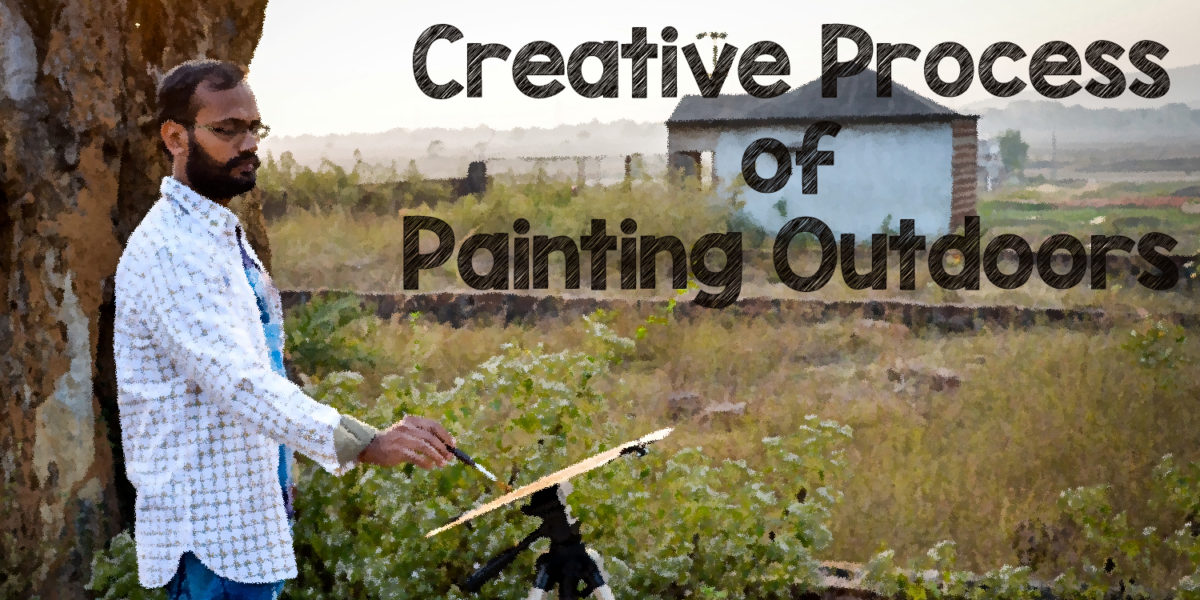“Painting from nature is not copying the object; it is realizing one’s sensations.” -Cezanne
The sparkling morning dew on the grass that’s still refreshingly damp to touch. The whispering wind that caresses, carrying on with it the faint whiff of wildflowers and the sounds of roosting birds. The rains that darken the sky, mist the horizon and tap a melody over rustling leaves. This is what the artist is faced with when painting en plein air – where all his senses of sight, smell, sound and touch are continuously engaged, where he is in direct contact with nature’s life force. And in turn, this lends to his art something that is so invigorating – that it never fails to touch a chord with the viewer. A work done in the comfort of indoors may be technically more accomplished, but nothing can match the vitality of a watercolor painted outdoor in natural light!
The above paragraph was penned down by one of my writer friends called Amit. And I think it really captures the essence of painting en plein air. Sometimes these forces of nature have such a strong effect that a painting just happens spontaneously. But still most times there is a creative process that is at work when artists paint outdoors. This process is necessary not only to make successful paintings, but also to maximize learning and the joy of painting outdoors. This week I am headed to IIT Kharagpur, my Alma Mater to capture few of its beautiful location en plein air. And I thought it will be a good time to discuss about my creative process of painting outdoors.
This is the second post in my series of posts on Creative process. In the first post of this series, I have talked about the creative process in a generic way.
The Creative Process of Painting Outdoors
Identifying subject and the sweet spot
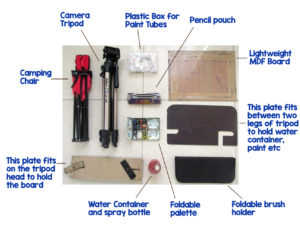
The first thing that happens in any creative process is Inspiration. Morning and afternoon light has the capability to turn mundane scenes to great subjects. Hence I generally prefer to look for inspiration in the morning or in the afternoon and avoid the flat noon light. A good subject does not necessarily mean a very beautiful scene. In fact sometimes a very beautiful scene may not turn out to be a great subject. What I aim to find in a scene is basically big abstract shapes, play of light and may be an interesting perspective. What I avoid is is clutter of too many shapes and colors. When I have found my subject, the next task is to find a good place to station myself for the next 2-3 hours from where I can observe the subject and paint. In fact the spot from where I paint generally becomes more important than the subject itself because if I am not comfortable in a place it is difficult for me to paint. When I find the perfect place for the perfect subject I call it sweet spot. All this exercise of finding a sweet spot involves quiet a bit of walking and exploration. Hence I keep my outdoor equipment very light and minimal and paint on papers that are no bigger than 11 x 15 inch (quarter sheet).
Getting a Feel
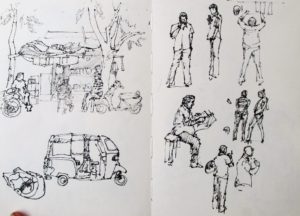
To begin with I only take out my portable chair and sketchbook and just start sketching anything that catches my eye. People, trees, buildings, cars, bikes, lamp post… It could just be anything. I just sketch to get a feel of the surrounding. Most of the times I would get my figures which later come into my paintings from these sketches itself. This exercise of getting a feel this way sets off the creative process of painting outdoors and it kind of prepares me mentally.
The Thumbnail and Idea Sketches
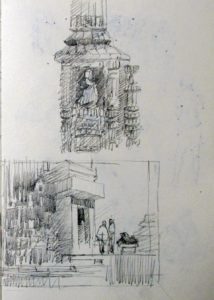
When I have sketched enough I start narrowing down on the scene that I would be painting. I look around through a view finder made with my palms to get an idea of the portion of the scene to paint. Squinting helps to identify the big shapes in the subject at this time. When I have found my subject I do a few thumbnail/composition studies to reduce the subject to 2-3 major tonal shapes. In these sketches I may move things around, add something that may not be there (without taking away from the subject), merge shapes together. This is an exercise to get my composition right without losing the tonal layout. Sometime I even color these sketches lightly to get an idea if my color scheme will work or not.
Execution – Spontaneity v/s Original Idea

When I am done with my preparation I finally setup my easel to paint. At this point I feel I have got it all worked out in my head. I feel very confident of making a great painting. I draw my subject and then start my painting with great enthusiasm. But somewhere in the middle of the painting many a times my world comes crashing down. I find myself completely lost. After all the medium I paint in is watercolor. And it has a mind of its own. It has its own powers to guide the painting. And when that happens its always better to go with the flow. Its better to change my plans and go in the direction watercolor wants me to go. Believe me or not, most of the times it does result in a better painting. The best parts in the paintings actually turns out to be what I did not paint, so to say.
Reflection
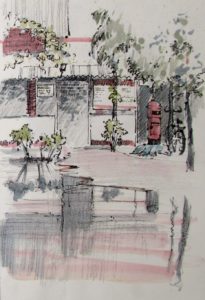
Ninety Nine percent of the times I am not happy with my painting on location. When I get back home I put my work in a drawer or a corner so that I cant see it for a few days. When I see it after a few days it does look much better. It is probably because I do not have the actual scene in front of me to compare with. But at the same time I look at it critically and if needed I make some tonal or color corrections. One trick I learnt from a friend is to take picture of the painting, print it and then try the corrections on the print first to check if it works or not. This way I can be sure that the changes to the painting will not kill it at least.
Indoor v/s Outdoor
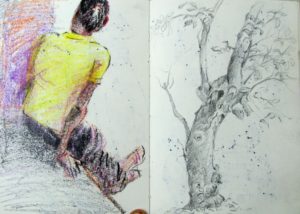
There are three major differences between working in the studio and working outdoors. First is the time factor. When you are painting outdoors you have to finish (or almost finish) your painting within a shorter time period. Second is the tools and materials that you can use will always remain limited. And third is that the outdoor environment is very dynamic and can be very uncomfortable. The secret to painting outdoors is to turn these into positives. Painting fast with a purpose often takes away over thinking and brings in spontaneity and freshness. Working with limited material makes the work simple which is the hall mark of a great watercolor work. And the dynamic environment is a great source of learning and also brings in new elements to one’s work.
In the end I would stress upon the fact that this is just a generalized process I follow. But in reality sometimes I don’t sketch at all and directly paint while at other times I keep sketching and never paint. While a process can help you never be afraid to go with your gut feel. Its more fun that way.
